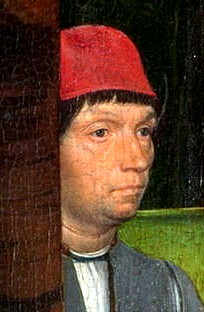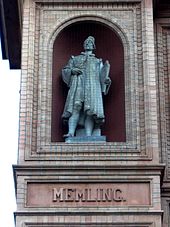Hans Memling

Hans Memling (* between 1433 and 1440 in Seligenstadt ; † August 11, 1494 in Bruges ; also Jan van Mimmelynghe , Johannes Memmelinc or Memlinc , incorrectly Hemling ) was a German painter of the Dutch school.
Life

His mother was probably Lucia Stirn , her first marriage to a wealthy citizen of Seligenstadt. His father is Hamann Momilingen . The father or both parents died in 1450 or 1451, probably as a result of a plague epidemic at the time . Exact information is missing about the parents' milieu, including with regard to Memling's exact date of birth, so that his early life is largely in the dark. He is first mentioned in a document in Bruges in 1465 when he acquired citizenship . In 1466 he rented a large stone house there in the Sint-Jorisstraat , which he probably bought in 1480. Later two adjoining houses with transverse structures are mentioned, which Memling may have lived in since the beginning of his time in Bruges. Mainly painters and miniaturists lived in that quarter, including the book illustrator Willem Vrelant . Memling would have been committed to the free championship to acquire, but settled for unknown reasons at the Bruges guild register and later worked in his workshop also assistants and apprentices. In 1480 a Hannekin Verhannemann is named as an apprentice , who later did not appear. Four years later, a Passchier vander Mesch turned up as an apprentice, who was just as insignificant. At the same time, Michel Sittow's apprenticeship in Bruges is documented, who, due to stylistic similarities, can be considered another apprentice to Memling. In 1487 Memling's wife Anna de Valkenaere died , who gave him three children: Jean, Nielkin and Nicolas. One year after Memling's death in 1494, the children were still minors (under 25 years of age) and remained on the property in the Sint-Jorisstraat until 1509 . He is buried in the churchyard of St. Aegidius in Bruges.

Memling's memory was initially kept in his place of birth, Seligenstadt, where masses were still read for him in the early 16th century. After that it was forgotten for the time being. As his main work, paintings in the St. John's Hospital in Bruges have been preserved, so that when he was rediscovered, a maudlin legend was spun about the painter who is said to have created the paintings in the St. John's Hospital after a miraculous healing. This legend lasted for a long time and was later translated into images by other painters. At times he was misinterpreted as Hemeling before recent research disproved the hospital legend and the wrong name. As Hemling his bust in the Walhalla called in Regensburg; the memorial on the facade of the Hamburger Kunsthalle bears the name Memling . In 2002 the asteroid (9562) Memling was named after him.
style
From his works it is clear that he was formed under or after Rogier van der Weyden . However, he softened its severity and gave his figures less elongated forms. Despite some angularities and thinness, they show graceful movement, and their delicate soul expression , their deep and true feelings captivate the beholder with great power. The naive amiability of his storytelling, his perfect mastery of color and modeling , his delicate care in handling are unique in his time, which is why the Italians particularly preferred him. In addition to the creation of religious works, Memling is also an important innovator of profane portraiture . More than a third of the extensive work he has survived consists of portraits of this genre. The art historian Dirk de Vos concludes from a comparison of groups of works by various contemporary artists that Memling - based on the art of Jan van Eyck and Rogier van der Weyden - created the basis for the Renaissance portrait in the Netherlands . A flower still life from Memling, kept in the Städel in Frankfurt am Main , is considered the earliest of its kind.
Works
- In the Louvre in Paris one of his most famous painting hangs: The portrait of an old lady with hood (1470/75). It is part of a double portrait, the counterpart of which is kept in Berlin and together result in the "portrait of an old married couple".
- The Last Judgment , 1467–1471, National Museum (Gdansk)
The main works of the artist are in the Johannishospital (Hôpital Saint-Jean or Sint-Janshospitaal) in Bruges :
- The reliquary of St. Ursula with 6 representations from the legend of the 11,000 virgins (1489)
- Marriage of St. Catherine ( winged altarpiece , 1479)
- Adoration of the three kings (also with wings, 1479)
- Portrait of Maria Moreel , depicted as Sibylla persica (1480)
- Madonna with the donor Martin van Nieuwenhoven (1487)
- In the Groeninge Museum in Bruges there is a triptych : in the middle the saints Christoph , Maurus , Aegidius , on the wings the founder Mayor Moreel with his family.
- In the Galleria Sabauda in Turin there is a plaque that presents the Passion of Christ (the seven sorrows of Mary ) in different small groups
- In the Alte Pinakothek in Munich a similar work with the seven joys of Mary.
- In the Musée des Beaux-Arts of Strasbourg there is the double-sided painted polyptych "Earthly Vanity and Divine Redemption"
- The winged altarpiece by Memling from 1491, originally in the Greveradenkapelle of Lübeck Cathedral , which shows the crucifixion of Christ in the middle , is now in Lübeck's St. Anne's Monastery .
- Bathsheba in the bath (around 1485), 191.5 × 84.5 cm, Staatsgalerie , Stuttgart .
- Christ surrounded by angels playing music , originally painted for the Monastery of Santa María la Real de Nájera , now in the Royal Museum of Fine Arts in Antwerp .
literature
- Till-Holger Borchert (Ed.): Hans Memling - Portraits. Exhibition cat. Belser, Stuttgart 2005, ISBN 3-7630-2448-4 .
- Dirk de Vos: Hans Memling. The complete work . Stuttgart / Zurich 1994, ISBN 3-7630-2312-7 .
- Dirk de Vos: Flemish Masters . DuMont, Cologne, ISBN 3-8321-7201-7 .
- Ingeborg Dorchenas: Memling, Hans. In: Biographisch-Bibliographisches Kirchenlexikon (BBKL). Volume 5, Bautz, Herzberg 1993, ISBN 3-88309-043-3 , Sp. 1232-1240.
- Peter Eikemeier: Memling, Hans. In: New German Biography (NDB). Volume 17, Duncker & Humblot, Berlin 1994, ISBN 3-428-00198-2 , pp. 29-31 ( digitized version ).
- Joseph Eduard Wessely : Memling, Hans . In: Allgemeine Deutsche Biographie (ADB). Volume 21, Duncker & Humblot, Leipzig 1885, pp. 307-309.
Individual evidence
- ↑ Minor Planet Circ. 47165
- ↑ Sam Segal: Flowers and nature, Netherlandish flower painting of four centurier. 's-Gravenhage 1990, p. 19.
- ^ Ina Conzen: Staatsgalerie Stuttgart, the collection: Masterpieces from the 14th to the 21st century , Hirmer, Munich 2008, ISBN 978-3-7774-7065-8 .
Web links
- Literature by and about Hans Memling in the catalog of the German National Library
- Works by Hans Memling at Zeno.org .
- Web Gallery of Art
| personal data | |
|---|---|
| SURNAME | Memling, Hans |
| ALTERNATIVE NAMES | Mimmelynghe, Jan van; Memmelinc, Johannes; Memlinc, Johannes; Hemling, Hans (wrong) |
| BRIEF DESCRIPTION | German painter of the Dutch school |
| DATE OF BIRTH | between 1433 and 1440 |
| PLACE OF BIRTH | Seligenstadt |
| DATE OF DEATH | August 11, 1494 |
| Place of death | Bruges |










